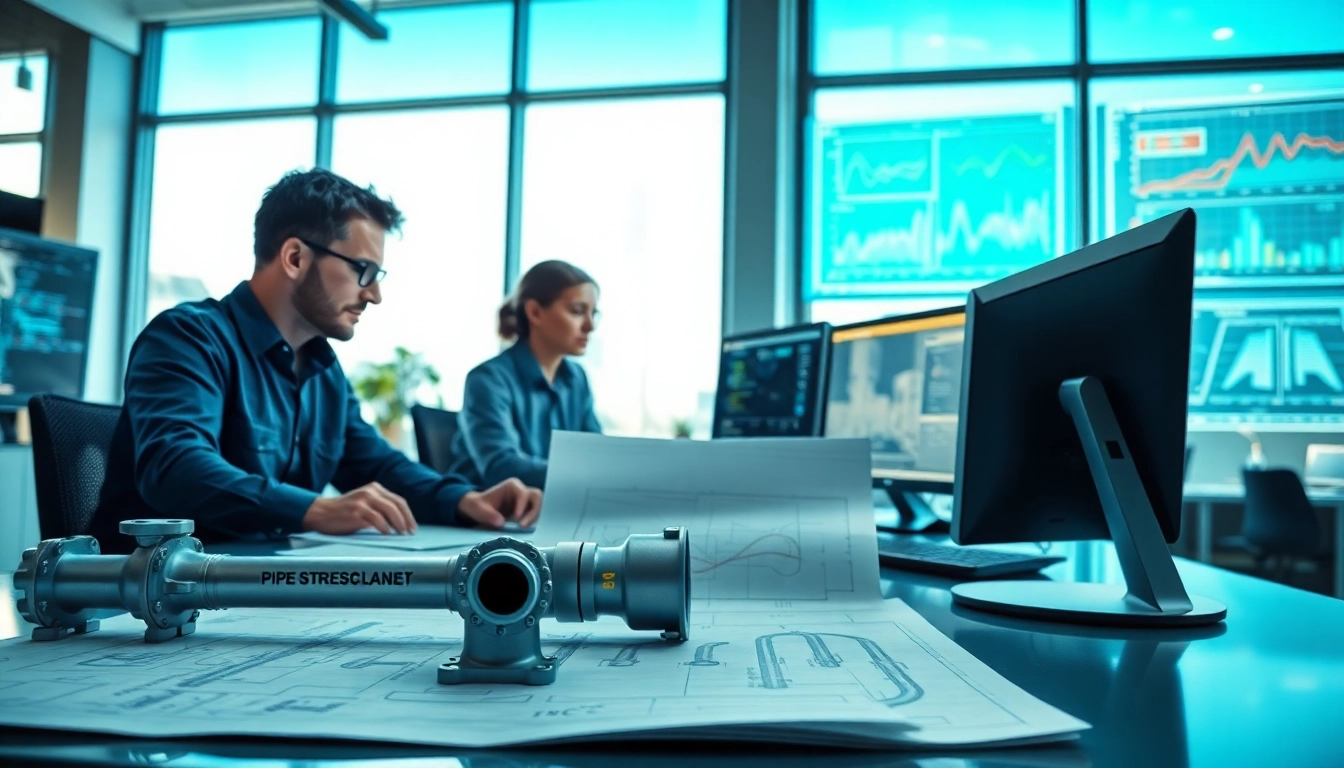Introduction to Pipe Stress Analysis
In the world of engineering, particularly in piping design and construction, understanding how piping systems behave under various conditions is critical. This encompasses understanding the physical stresses that these systems experience during operations. A pipe stress Company plays a pivotal role in ensuring that piping systems are designed and implemented to withstand operational stresses, thereby preventing failures that could lead to catastrophic accidents. This article delves into the definition, importance, and fundamental concepts of pipe stress analysis, emphasizing the necessity of specialized companies in this field.
What is Pipe Stress Analysis?
Pipe stress analysis refers to the engineering methodology used to evaluate the stresses encountered by piping systems under various load conditions, such as thermal effects, pressure changes, and weight. It involves the practical application of mechanical engineering principles to ensure that piping installations can withstand operational loads without failing. Key areas of focus include calculating displacement, analyzing system performance, and considering materials used in piping installations.
Importance of Pipe Stress Companies
Pipe stress companies are vital for various industries such as oil and gas, chemical processing, power generation, and water treatment. They provide expert analysis that not only mitigates the risk of failures but also ensures compliance with industry standards. Their expertise leads to efficient design practices, risk assessments, and longevity in piping systems, which can save costs in the long run. By ensuring pipes are stress-tested, these companies help in minimizing structural failures and addressing any engineering challenges up front.
Key Terminology in Pipe Stress Analysis
Understanding the niche of pipe stress analysis requires familiarity with specific terminology. Here are some key terms:
- Load: Forces applied to the piping system, including thermal loads, pressure loads, and weight loads.
- Stress: The internal forces per unit area within the material, expressed typically in units of psi or MPa.
- Displacement: The movement from an original position due to applied loads.
- Allowable Stress: Maximum stress levels that materials can endure without failure, as defined in relevant codes and standards.
- Flexibility Analysis: An assessment to determine how much a pipe can bend under load without incurring damage or exceeding allowable limits.
Understanding the Principles of Pipe Stress Engineering
Fundamental Concepts of Stress Analysis
At the core of any pipe stress analysis are several fundamental concepts that are crucial for engineers to understand. These concepts allow professionals to predict how piping systems react under various conditions. Some of these include:
- Static and Dynamic Loads: Load conditions can be static, remaining constant for a period, or dynamic, changing rapidly. Stress analysis must consider both scenarios to ensure system integrity.
- Thermal Expansion: Changes in temperature affect the length and integrity of piping. Understanding how materials react to temperature variations is key in designing flexible joints and supports.
- Support Structures: Proper placement and type of supports are essential to maintain the stability of the piping system. Various support types (e.g., brackets, hangers) manage weight and movement.
The Role of Materials in Stress Calculations
Material selection significantly affects the outcomes of pipe stress analysis. Different materials exhibit varied properties in relation to tensile strength, flexibility, and resistance to temperature changes. For instance, steel pipes can withstand high pressures but may be more susceptible to corrosion over time. On the other hand, materials such as PVC, while lightweight and resistant to corrosion, may not handle high-temperature applications efficiently. The choice of material leads to specific considerations in stress analysis to ensure longevity and performance of the piping system.
Common Challenges Faced by Pipe Stress Companies
Despite advances in technology and analysis methods, pipe stress companies often encounter several challenges:
- Complex Geometry: Unique piping layouts can introduce challenges in accurately modeling the system’s behavior.
- Interdisciplinary Coordination: Effective stress analysis requires cooperation between multiple engineering disciplines, including mechanical and civil engineering.
- Regulatory Compliance: Adhering to various national and international standards can complicate the design process and increase project timelines.
- Technological Limitations: While software has improved, limitations exist in accurately modeling certain dynamic effects without oversimplification.
Industry Standards and Best Practices
Overview of ASME Standards for Pipe Stress
The American Society of Mechanical Engineers (ASME) establishes key standards and guidelines for the design and analysis of piping systems. Among the most important are:
- ASME B31.1: Pertains to power piping, setting forth criteria for the design, materials, fabrication, assembly, examination, and testing of piping systems.
- ASME B31.3: Addresses Process Piping, applicable in chemical, petroleum, and related industries, focusing on safe transport of industrial fluids.
- ASME B31.8: Relates to gas transmission and distribution piping systems.
By adhering to these standards, pipe stress companies can ensure their designs meet necessary safety and performance criteria.
Best Practices for Accurate Stress Analysis
Achieving accurate stress analysis involves maintaining numerous best practices, including:
- Detailed Load Assessment: Accurately accounting for all loads—operational, environmental, and temporary—ensures a comprehensive assessment.
- Regular Updates to Modeling Software: Utilizing the latest software versions ensures that the most accurate calculations can be performed.
- Validation of Results: Cross-checking results through alternative methods or calculations can help confirm the reliability of the analysis.
- Documentation: Comprehensive records of analysis procedures, assumptions, and results are crucial for future reference and inspections.
Regulatory Compliance for Pipe Systems
Regulatory compliance is a major aspect of pipe stress analysis. Engineers must advocate for adherence to local, national, and international laws governing engineering practices. This may include:
- Safety Regulations: Ensuring the design meets safety codes reduces risk during construction and operation.
- Environmental Standards: Assessing potential environmental impacts and ensuring designs minimize negative effects is essential.
- Quality Assurance Protocols: Implementing procedures for quality control at all stages of design, installation, and maintenance helps ensure compliance.
Innovations in Pipe Stress Analysis Technology
Advancements in Software Tools
The introduction of specialized software for pipe stress analysis has transformed the industry. Advanced software allows for the creation of detailed models that can simulate various conditions affecting pipe behavior. Some notable software includes:
- CAESAR II: This widely acknowledged tool performs comprehensive pipe stress analysis, providing results that allow engineers to optimize piping systems.
- ROHR2: Known for versatility, it accommodates complex systems and provides extensive data for stress calculations.
- SST’s CAEPIPE: A user-friendly option that offers powerful stress analysis capabilities while ensuring compatibility with various engineering practices.
The Impact of 3D Modeling on Analysis Accuracy
3D modeling has ushered in significant improvements in how piping systems are analyzed. By visualizing systems in three dimensions, engineers can identify potential issues before construction.
3D models allow for:
- Improved Visualization: Complex layouts become easier to grasp, enabling better communication between interdisciplinary teams.
- Enhanced Collaboration: Stakeholders can visualize design elements, facilitating collaborative problem-solving.
- Detailed Analysis: Engineers can assess how various materials and sizes interact in a three-dimensional space, allowing for precise calculations.
Future Trends in Pipe Stress Engineering Solutions
The future of pipe stress engineering is likely to be defined by increasing automation and integration of artificial intelligence (AI). Innovations such as:
- Predictive Analytics: Using historical data to predict performance issues and maintenance, reducing unexpected downtime.
- Digital Twins: Creating a virtual replica of physical systems allows for real-time monitoring and predictive maintenance.
- Integration of IoT: Internet of Things technology can facilitate continuous monitoring of piping systems, providing actionable data to prevent failures.
Choosing the Right Pipe Stress Company
Evaluating Company Expertise and Experience
When selecting a pipe stress company, it’s essential to evaluate their experience and expertise in the industry. Considerations include:
- Industry Experience: Companies with a long-standing history in the industry often have refined methodologies and a wealth of knowledge.
- Project Portfolio: Review previous projects and case studies to understand their capabilities and outcomes.
- Certifications: Look for companies that possess relevant certifications, demonstrating adherence to industry standards.
Key Services Offered by Leading Firms
Leading pipe stress companies typically offer a range of services, including:
- Consultation Services: Providing expert advice to ensure designs meet safety and operational requirements.
- Custom Software Solutions: Developing tailored solutions for unique piping challenges encountered by clients.
- Training and Support: Offering training for staff to enhance their understanding of stress analysis and the tools used.
Case Studies and Success Stories
Evidence of a company’s success in the field can often be seen through case studies. One notable case involved a major oil company facing issues with thermal expansion in a high-pressure pipeline. The chosen pipe stress company performed an extensive analysis, identifying critical areas needing additional support structures. After implementing recommended solutions, the company achieved a 25% reduction in stress-related incidents over the following year, showcasing the tangible benefits of effective pipe stress analysis.



